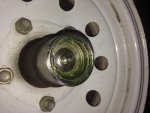zippy83
Chief Petty Officer
- Joined
- Jan 1, 2013
- Messages
- 491
Hi,
I think I am douing this wrong. I was told by a guy who works with me to grease the bearings but he told me to apply some of the grease on my index finger and remove the cap, then apply around it. That is what I did but I also noticed that when I took the cap off there is a valve. I am asuming this is for the grease?
Picture is attached.

Thanks
Zipp
I think I am douing this wrong. I was told by a guy who works with me to grease the bearings but he told me to apply some of the grease on my index finger and remove the cap, then apply around it. That is what I did but I also noticed that when I took the cap off there is a valve. I am asuming this is for the grease?
Picture is attached.

Thanks
Zipp



















